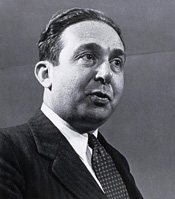Leo Szilárd was one of the founding fathers of EMBL and EMBO
In the autumn of 1962, Leo Szilárd met with Victor Weisskopf and Gilberto Bernardini to discuss Szilárd’s idea that a European laboratory for molecular biology should be established. They then got in touch with a number of molecular biologists, including Sir John Kendrew, Francis Crick, Sydney Brenner and James Watson, all of whom showed interest. Slowly the idea began to take shape and in August of 1963, a meeting was held in Ravello, Italy, which resulted in three main proposals:
- That the project should be European and not world-wide
- That in addition to a laboratory, fellowships and advanced teaching courses should be provided
- That a formal body known as the European Molecular Biology Organisation should be established
To honor Leo Szilárd’s role in the foundation of EMBL, on suggestion of Sir John Kendrew (the first EMBL DG), EMBL library was named after Leo Szilárd.
Biographical note
The Hungarian-American physicist, Leo Szilárd was best known for a patent for the neutron-induced nuclear chain reaction, and together with Enrico Fermi, the construction of the first nuclear reactor.
Born into a Jewish family in Budapest on 11 February 1898, Leo Szilárd emigrated to Germany after the First World War. There Szilárd studied physics in Berlin, where he got to know Albert Einstein and other top physicists, carrying out pioneering work linking thermodynamics with information theory.
In 1933, he moved to London, and in 1937 he left England to take up a post at Columbia University in New York. During the 1930s, he advised scientists not to publish results of chain reaction research, fearing the misuse of its dangerous possibilities. But equally aware of the danger at that time of Nazi Germany developing an atomic bomb first, he pressed the US government to support nuclear research and in 1939 helped persuade Albert Einstein to write to president Roosevelt advocating the immediate development of the atomic bomb. Thus, Leo Szilárd became one of the key scientists involved in the Manhattan Project.
Although Szilárd had succeeded in helping to create the nuclear bomb, he failed in his passionate attempts to restrain its use. After Hiroshima, he worked intensely to advocate the peaceful applications of atomic energy and the international control of nuclear weapons.
He was a scientist who was deeply concerned with world peace and with efforts to create what he called “a more livable world”. He circulated petitions among the scientists demanding greater scientific input on the future use of atomic weapons.

In 1962, he founded the Council for a Livable World whose symbol was a dolphin; this same dolphin motif was incorporated in the first library book-plates as a reminder of this aspect of his life’s work.
Szilárd died in California in 1964.
The Register of Leo Szilárd papers is publicly available at the Mandeville Special Collections Library, University of California, San Diego.
EMBL Szilárd Library holds a Special collection dedicated to Leo Szilárd with books written by, or about, or citing Leo Szilárd, respecting the legacy of honoring Leo Szilárd and his significance for EMBL, science and the world peace.
